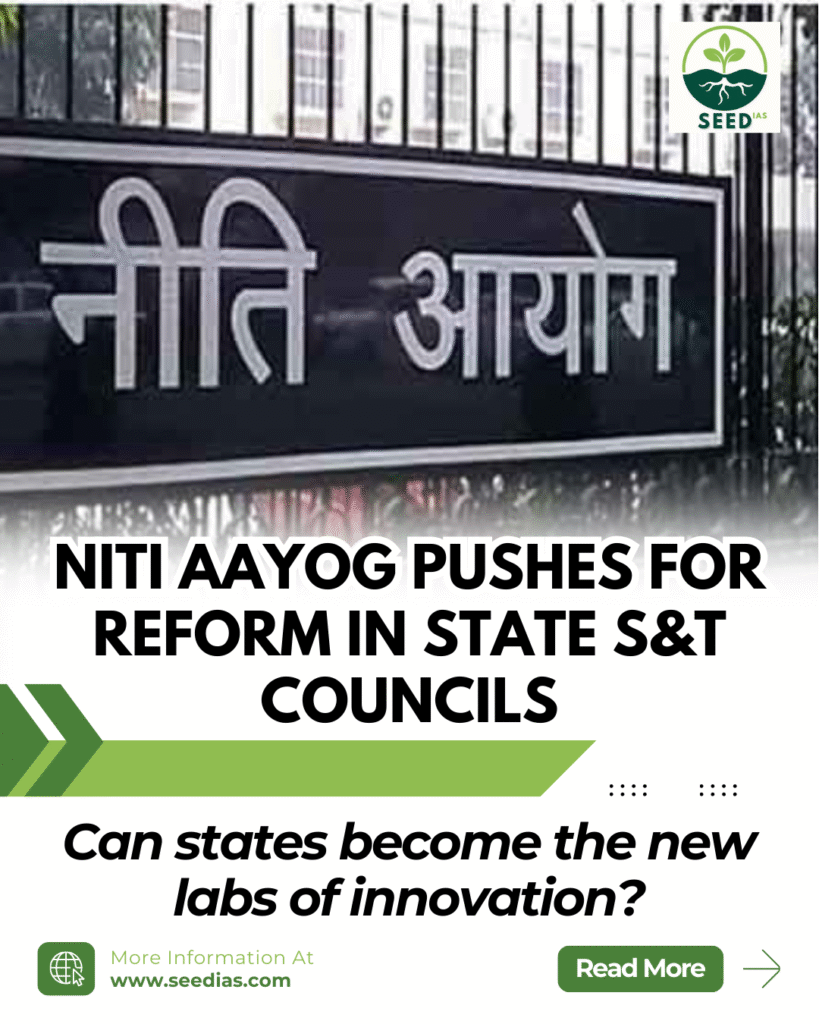Why in NEWS
NITI Aayog, in its report titled “A Roadmap for Strengthening State Science and Technology (S&T) Councils”, has recommended sweeping reforms to improve the functioning, funding, and governance of State S&T Councils. It highlights poor central support, weak institutional capacity, and lack of scientific leadership as critical roadblocks to state-level innovation and calls for performance-linked funding and institutional restructuring.
Key Terms and Facts
| Term / Fact | Explanation |
|---|---|
| SSTCs (State S&T Councils) | Autonomous bodies created by states (since 1971) to promote science, technology, and innovation aligned to local needs. |
| First States to establish SSTCs | Karnataka, Kerala, Uttar Pradesh, West Bengal. |
| STI (Science, Technology & Innovation) | Policy area involving research, scientific temper, tech application, and innovation for development. |
| SSTP (State Science & Technology Programme) | Central scheme by DST to support state-level S&T initiatives through grants and collaboration. |
| Department of Science and Technology (DST) | Central ministry under Government of India that funds and supports scientific research and innovation across the country. |
| Centre-State S&T Partnership | A collaborative model where central and state governments co-develop and co-fund S&T projects. |
| Core Grants | Non-performance-based fixed funds provided by DST to S&T Councils. These form the primary support for most states. |
| Performance-Based Funding | A funding model recommended by NITI Aayog where grants are linked to measurable outcomes and innovation impact. |
| IPR (Intellectual Property Rights) | Legal rights (like patents, GIs) to protect innovation; Tamil Nadu leads in filings through its Patent Information Centre. |
| PIC (Patent Information Centre) | A state-level agency to help innovators file patents and GIs; Tamil Nadu’s PIC won a national award in 2023. |
| Science Cities & Innovation Hubs | Large science learning and research complexes. Example: Gujarat Science City, Ahmedabad. |
| SSR (Scientific Social Responsibility) | An initiative to align scientific research and knowledge with social needs. |
| CSR (Corporate Social Responsibility) | Mandated corporate contributions towards development and innovation under Companies Act, 2013. |
| STI Information Cells | Proposed nodal cells to manage state-level S&T data and guide policy decisions. |
| GSDP (Gross State Domestic Product) | Economic output of a state. NITI recommends at least 0.5% of GSDP be allocated for S&T. |
| Innovation Facility Centre (IFC) | Mizoram’s model for supporting grassroots innovators through institutional and technical assistance. |
| National Monitoring System | Proposed central mechanism to track progress, efficiency, and performance of all state S&T councils. |
| Aromatic Plant Cultivation (Manipur) | A state-level R&D-driven initiative under the National Mission on Medicinal & Aromatic Plants. |
| Paddy Straw Management (Punjab) | A tech-based initiative by Punjab to reduce stubble burning, create rural jobs, and support green economy. |
News Highlights
- SSTCs were set up since 1971 to decentralize S&T decision-making.
- Despite high expectations, many councils are underfunded and underperforming.
- Some states like Tamil Nadu, Kerala, Punjab, and Mizoram have shown innovation success stories.
- NITI Aayog recommends appointing scientists (not bureaucrats), introducing performance-based funding, and creating innovation hubs across states.
- It also suggests forming STI Data Cells and establishing a national monitoring system.
Role of State S&T Councils in India
| Aspect | Details |
|---|---|
| Introduction | Science, Technology, and Innovation (STI) are central to national development and are supported by both Central and State departments. |
| Origin | Started in 1971 by C. Subramaniam. First councils in Karnataka, Kerala, UP, and West Bengal. |
| Current Status | SSTCs are present in almost all States and Union Territories. |
| Central Support | Supported under DST’s State S&T Programme (SSTP); DST offers budgetary support. |
| State Funding | State governments also fund SSTCs, but support levels vary widely. |
| Key Functions | – Grassroots innovation enablers – Focus areas: agriculture, renewable energy, disaster management, biotech – Promote scientific solutions for resource management and quality of life – Encourage scientific attitude and awareness in society |
Key Challenges Faced by State S&T Councils
| Challenge | Explanation |
|---|---|
| Overdependence on DST Grants | Councils rely mostly on DST core funding, with little effort to tap other ministries. |
| Low Central Financial Support | Gujarat: ₹300 crore budget, only ₹1.07 crore from DST Kerala: ₹150 crore budget, zero from DST. |
| Minimal State R&D Share | States contribute only 6.7% to national R&D, vs 44% from Centre. NE states face major budget limitations. |
| Weak Industry-Academic Linkages | Poor collaboration with PSEs, IITs, IIMs affects applied research. |
| Fund Utilization Imbalance | Inconsistent use of funds leads to inefficiencies across states. |
| Low Research Output | Majority of national R&D output is from centrally funded institutes; states lag behind. |
| Budget Cuts | FY24–25 shows growth in overall funding (+17.65%), but reductions in Sikkim (-16.16%), Tamil Nadu (-4%), and Uttarakhand (-5%). |
| Poor Adaptability | Councils struggle to keep up with new R&D trends. |
| Lack of Scientific Leadership | Councils often led by bureaucrats instead of S&T experts. |
| Staffing Issues | Vacant posts, lack of full-time scientists, poor morale due to funding constraints. |
Success Stories of State S&T Councils
| State | Initiative |
|---|---|
| Kerala | Fellowship programs for women scientists to return after career breaks. Over ₹170 crore annually allocated to science initiatives. |
| Tamil Nadu | National leader in patent, GI, and industrial design filings. PIC awarded National Intellectual Property Award 2023 (Special Citation). |
| Punjab | Paddy straw management project: curbed pollution, boosted local economy, created jobs, promoted sustainability. |
| Mizoram | Innovation Facility Centre (IFC): 82 innovation-related products, 93 non-innovative. Works with NIF, NIT Mizoram for grassroots innovation. |
| Manipur | Cultivation of aromatic plants under National Mission; created rural jobs and positioned state as aroma-based product hub. |
Key Reforms Suggested by NITI Aayog to Strengthen SSTCs
| Reform Area | Details |
|---|---|
| Scientific Leadership | Councils should be headed by full-time scientists, not bureaucrats. |
| Performance-Based Funding | Replace flat core grants with performance-linked funding. Small NE/UT councils may retain some core support. States to allocate ≥0.5% GSDP to S&T. |
| Secure Research Jobs | Offer long-term, secure positions with career growth to retain talent. |
| Academic-Industry Linkages | Strengthen collaboration with industries and academic institutions (e.g., IITs, IIMs). |
| Science Cities & Innovation Hubs | One in every state. Example: Gujarat Science City with Robotics Gallery. These act as research–education–industry integration zones. |
| STI Information Cells | Set up to collect state-level science and innovation indicators. Enables data-driven policymaking. |
| SSR/CSR Coordination | Councils should act as nodal bodies for Scientific Social Responsibility (SSR) and Corporate Social Responsibility (CSR) efforts. |
| National Monitoring System | Track council performance regularly and hold them accountable for progress and fund utilization. |
In a Nutshell
Memory Code: SCI-TECH MAPS
S – Secure jobs and career growth for researchers
C – CSR/SSR cells to link research with society
I – Innovation hubs and Science Cities in all states
T – Tracking system for national monitoring
E – Enable academic-industry linkages
C – Core grants replaced by performance-based funding
H – Headed by scientists, not bureaucrats
M – Minimum 0.5% of GSDP to be spent on R&D
A – Aromatic plant and IP-based models as success stories
P – Poor central funding despite high expectations
S – State-level STI Cells for real-time data and policy input
Prelims Questions
- Which ministry supports State Science and Technology Councils under the State S&T Programme?
A) Ministry of Education
B) Ministry of Electronics and IT
C) Ministry of Science and Technology
D) NITI Aayog - Which of the following is a reform suggested by NITI Aayog to strengthen State S&T Councils?
A) Creation of new IITs under the councils
B) Headed by bureaucrats with fixed tenure
C) Performance-based funding system
D) Transfer of S&T councils to private entities - Which state has received a national award for promoting Intellectual Property Rights through its Patent Information Centre (PIC)?
A) Gujarat
B) Kerala
C) Punjab
D) Tamil Nadu
Mains Questions
-
State Science and Technology Councils were envisioned to decentralize innovation and address region-specific scientific challenges. Critically analyze their current limitations and discuss how NITI Aayog’s recommendations could revitalize their functioning.(10 Marks) GS 3
Discuss the importance of decentralised science governance in a diverse country like India. Evaluate how success stories from states like Kerala, Tamil Nadu, and Mizoram can inform future policies to strengthen state-level S&T ecosystems.(15 Marks) GS 3
Prelims Answer Key with Explanation
| Qn | Answer | Explanation |
|---|---|---|
| 1 | C | The State Science and Technology Programme is managed by the Department of Science and Technology under the Ministry of S&T. |
| 2 | C | NITI Aayog recommends replacing core grants with performance-based funding to boost efficiency and innovation. |
| 3 | D | Tamil Nadu received the National IP Award 2023 (Special Citation) for its strong record in patent filings and IP awareness through its PIC. |
















